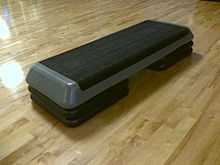Step aerobics


Step aerobics is a form of aerobic power distinguished from other types of aerobic exercise by its use of an elevated platform (the step). The height can be tailored to individual needs by inserting risers under the step. Step aerobics classes are offered at many gyms and fitness centers which have a group exercise program.
Step aerobics was innovated by Gin Miller around 1989. After a knee injury, Gin consulted with an orthopedic doctor, who recommended she strengthen the muscles supporting the knee by stepping up and down on a milk crate and from this she developed the step regimen.
Step aerobics can also be involved in dancing games, such as Dance Dance Revolution or In the Groove.
Moves & Techniques
Often moves are referred to as Reebok step moves in reference to one of the first makers of the plastic step commonly used in gyms.
The "basic" step involves stepping one foot first on the step then the other on top of the platform then stepping the first foot back on the floor with the second following. A "right basic" would involve stepping right foot up, then the left, then returning to the floor alternating right then left.
Many instructors of step will switch immediately between different moves, for example between a right basic and a left basic without any intervening moves, forcing people to "tap" their foot instead of shifting weight. However, one form of step is called tap-free or smooth step in which feet always alternate without the ambiguous "taps" that can make learning step difficult for beginners. This requires a bit of foresight and planning by the instructor in order to insert a transitional or switching move that maintains the natural alternating weight shift akin to walking. For example, from a series of right basics one may insert a "knee up" (which involves stepping up and lifting the knee and returning the lifted leg to the ground, thereby switching feet) and then continuing to a left basic. However, this requires planning and the extra beats required for the transitional move.
Common Moves include:
- Basic Step
- Corner knee (or corner kick)
- Repeater knee (aka Triple knee)
- T-Step
- Over-the-Top
- Lunges
- V-Step
- Straddle Down
- L-Step
- Split Step
- I-Step
Choreography
Many instructors will prepare a set of moves that will be executed together to form the choreography of the class. Usually, the choreography will be timed to 32 beats in a set, ideally switching legs so that the set can be repeated in a mirrored fashion. A set may consist of many different moves and the different moves may have different durations. For example, a basic step as described above takes 4 beats (for the 4 steps the person takes). Similarly, the "knee up" move also takes 4 beats. Another common move, the repeater knee, is an 8-beat move.
Classes vary in the level of choreography. Basic level classes will tend to have a series of relatively basic moves strung together into a sequence. More advanced classes incorporate dance elements such as turns, mambos, and stomps. These elements are put together into 2-3 routines in each class. One learns the routines during the class and then all are performed at the end of the class. Regardless, of the complexity of the choreography, most instructors offer various options for different levels of intensity/dance ability while teaching the routines.
Benefits
Step aerobics helps burn calories and fat. It also helps to reduce stress, promote restful sleep, strengthen muscles and gives the body a more streamline appearance. The number of calories burned depends on the speed of movements, step height, and length of exercise. Exercise sessions can create social connections with others and step as well as low-impact aerobics is suitable for all ages, low cost, and has no restrictions on place.